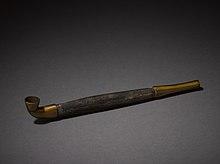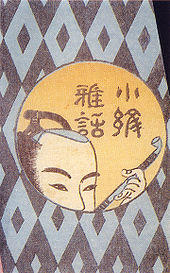Kiseru (煙管) is a Japanese smoking pipe traditionally used for smoking a small serving (about 25 mg) of kizami, a finely shredded tobacco product resembling hair.[1]

Typically the mouth piece and bowl are made from metal, with a tubular shaft of wood or bamboo stretching in between. The bowl is much smaller than that of western-style pipes. Because each kiseru is basically a rod with metal ends, extremely long kiseru could be carried as weapons, especially by the gangster-like kabukimono samurai of Edo period Japan. Many kiseru have been engraved with elaborate details by skilled artisans and were a status symbol for the owner.
Tobacco has been known in Japan since the 1570s at the earliest. By the early 17th century, kiseru had become popular enough to even be mentioned in some Buddhist textbooks for children. The kiseru evolved along with the equipment and use of incense associated with the Japanese incense ceremony: kōdō:
- The kō-bon, an incense tray, became the tabako-bon, a tobacco tray
- the incense burner evolved into a charcoal fire pot for lighting tobacco with hot air
- The incense pot became a jar to contain the ash.[2]
During a smoking session, the smoker would put a ball of stringy kizami tobacco in the bowl, light it at the charcoal fire, then dump the ash into the ash container.
During the Edo period weapons were frequently used as objects to flaunt one's financial status. Since commoners were prohibited to carry sharper weapons, an elaborate kiseru carried slung from the waist often served the purpose. After the Meiji restoration and the abolishment of the caste system, many craftsmen who previously had worked on decorating swords moved on to designing kiseru and netsuke for tobacco pouches.
The word "kiseru" today is more commonly used to refer to the practice of defrauding the railway system by buying two cheap tickets to get past the entrance and exit gates while not paying for the distance between them. This is likened to a kiseru as there is only metal at the ends, and nothing in the middle, a metaphor indicating that money (metal) only covers the beginning and end.[3]
Notes
- ^ Scott David Foutz (2009). "Kiseru - Traditional Japanese Pipe". Archived from the original on 2011-03-10. Retrieved 2010-06-16.
- ^ http://www.jti.co.jp/sstyle/trivia/know/episode/2005/02/02.html Japan Tobacco Incorporated official website. accessed Aug 11, 2008
- ^ "Japan Train Fare Scams on the Rise". Tokyo Weekender. February 1, 2018.
Bibliography
- Smoke: a global history of smoking (2004) edited by Sander L. Gilman and Zhou Xun ISBN 1-86189-200-4
